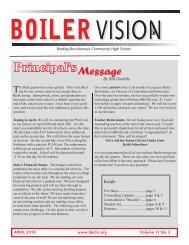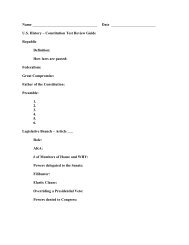Biology Semester 2 Final Exam Review Cell Reproduction 1. Define ...
Biology Semester 2 Final Exam Review Cell Reproduction 1. Define ...
Biology Semester 2 Final Exam Review Cell Reproduction 1. Define ...
You also want an ePaper? Increase the reach of your titles
YUMPU automatically turns print PDFs into web optimized ePapers that Google loves.
<strong>Biology</strong><br />
<strong>Semester</strong> 2 <strong>Final</strong> <strong>Exam</strong> <strong>Review</strong><br />
<strong>Cell</strong> <strong>Reproduction</strong><br />
<strong>1.</strong> <strong>Define</strong> the following terms:<br />
Haploid<br />
Diploid<br />
Crossing Over<br />
Somatic <strong>Cell</strong><br />
Gamete<br />
Tetrad<br />
Karyotype<br />
2. Explain the chromosomes that are in body and sex cells.<br />
3. A diploid cell has 24 chromosomes. How many chromosomes will a sperm cell<br />
have<br />
4. Explain the major function of each process:<br />
a. meiosis<br />
b. mitosis<br />
Genetics<br />
<strong>1.</strong> Who is Gregor Mendel and why is he important<br />
2. <strong>Define</strong> the following words:<br />
a. homozygous<br />
b. heterozygous
c. allele<br />
d. dominant<br />
e. recessive<br />
f. phenotype<br />
g. genotype<br />
h. punnett square<br />
i. parental generation<br />
j. F1 generation<br />
3. Write the following genotypes for the phenotypes. Green is dominant over<br />
yellow.<br />
Homozygous green_________ Heterozygous ___________ Yellow____________<br />
4. If a female has blue eyes and a male is heterozygous brown eyed, what will be<br />
the phenotypes and genotypes of their offspring<br />
5. Complete the dihybrid below.<br />
R=green<br />
Y=smooth<br />
r=yellow<br />
y=wrinkled<br />
RY Ry rY ry<br />
RY<br />
Ry<br />
RY<br />
Ry<br />
What is the genotypic ratio<br />
What is the phenotypic ratio<br />
6. What is a sex-linked trait<br />
7. Give an example of a sex-linked trait.
8. What is the purpose of a pedigree<br />
A circle represents a _____________. A square represents a __________________.<br />
E=not having dimples e=dimples FILL OUT THE PEDIGREE.<br />
9. Explain incomplete dominance and codominance.<br />
10. What is the difference between genetics and heredity<br />
DNA and protein synthesis<br />
<strong>1.</strong> <strong>Define</strong> the following words:<br />
a. Nucleotide<br />
b. DNA<br />
c. mRNA<br />
d. tRNA<br />
e. rRNA<br />
f. polypeptide<br />
g. DNA replication<br />
h. Transcription<br />
i. Translation<br />
j. Codon and Anticodon<br />
k. Mutation
2. Replicate the DNA strand below.<br />
A T G G C A T T C G G<br />
Transcribe the strand you just created.<br />
Translate the strand.<br />
3. Name 2 similarities between DNA and RNA.<br />
Name 2 differences between DNA and RNA.<br />
4. Draw a nucleotide and label it with its 3 parts.<br />
Describe the structure of DNA in detail!
5.Explain what is taking place in the picture. Make sure to describe each letter.<br />
Evolution and Taxonomy<br />
<strong>1.</strong> Explain Miller and Urey’s experiment.<br />
2. Who is Charles Darwin<br />
Where did he do most of his work<br />
What did he mostly study here and what was its significance<br />
3. Describe natural selection.<br />
4. <strong>Define</strong> adaptation.<br />
Give an example of an adaptation.
5. <strong>Define</strong> and give two examples of each word.<br />
a. vestigial structure<br />
b. homologous structure<br />
6. Why does natural selection take place<br />
7. List the types of evidence that support the theory of evolution.<br />
8. What is evolution<br />
9. What is a fossil<br />
Give 3 examples.<br />
Explain their formation.<br />
Classification<br />
<strong>1.</strong> <strong>Define</strong> taxonomy.<br />
2. Describe Linnaues’ contribution to classification.<br />
3. Write the classification table from the largest category to the smallest category.<br />
4. Describe how to write a scientific name. Give an example.<br />
5. What is a cladogram Draw an example.<br />
6. List the 3 domains and the kingdoms that would be placed in each one.
7. Fill out the chart below for the six kingdoms.<br />
KINGDOM EUKARYOTIC/<br />
PROKARYOTIC<br />
UNICELLULAR<br />
OR MULTICELLULAR<br />
Animalia<br />
Plantae<br />
Protista<br />
Fungi<br />
Eubacteria<br />
Archaebacteria<br />
FEEDING PATTERN<br />
Autotrophic/heterotrophi<br />
c<br />
Ecology<br />
<strong>1.</strong> <strong>Define</strong> the following words.<br />
a. ecosystem<br />
b. population<br />
c. community<br />
d. biosphere<br />
e. abiotic factor<br />
f. biotic factor<br />
g. population density<br />
h. trophic level<br />
i. biomass pyramid<br />
j. herbivore<br />
k. carnivore<br />
l. producer<br />
m. consumer<br />
n. omnivore<br />
o. habitat<br />
2. What is in a niche<br />
3. What would be some of the possible limiting factors of an animal population
4. Create a food chain with the following animals: bird, grass, insect, and dog<br />
Circle the producer. Star the primary consumer.<br />
5. What is the difference between a food chain and food web<br />
.<br />
6. Above is an energy pyramid. How much energy is available to be passed on<br />
from:<br />
Producers to primary consumers<br />
Primary consumers to secondary consumers<br />
Secondary consumers to tertiary consumers<br />
7. List the different types of biomes. Circle Illinois’ biome.






![New Student Course Guide[2] - Bradley-Bourbonnais Community ...](https://img.yumpu.com/47451319/1/190x245/new-student-course-guide2-bradley-bourbonnais-community-.jpg?quality=85)









